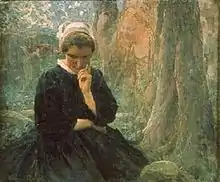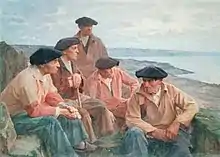Henri Royer
Henri Paul Royer (22 January 1869, Nancy – 31 October 1938, Neuilly-sur-Seine) was a French painter, remembered especially for his genre works from Brittany.
Henri Paul Royer | |
|---|---|
 Henri Royer Painting on the Île de Sein, old postcard | |
| Born | 22 January 1869 Nancy, France |
| Died | 31 October 1938 (aged 69) Neuilly-sur-Seine, France |
| Occupation | Painter |
Painter of genre, portraitist and landscape artist, he travels both in America and Europe during his life.
Biography

Henri Royer is the son of Jules Royer (1845-1900), creator of one of the most important lithographic printing works established in Nancy, rue de la Salpêtrière.[1] Raised in the art world from a young age, Royer joined the Nancy School of Fine Arts where he met Émile Friant.[2] He attended the classes of Antoine Vierling and Louis-Théodore Devilly[3] and exhibited his first works at the Salon de Nancy, including Fight between two young typos and Young plasterer. These early successes prompt his parents and teachers to encourage a study trip to Holland with Friant, who would then influence Royer.[4]
At his return in 1888, and after attending the École des Beaux-Arts in Paris, in 1890 he continued his studies at the Académie Julian under Jules Joseph Lefebvre and François Flameng. He exhibited regularly at the Paris Salon, specializing in genre paintings and portraits. As a portraitist, he encountered many famous figures from the aristocracy, politics, diplomacy, science and the arts. As a result, his critics described him as one of Ingres' disciples.[5]
_-_Famille_bretonne_en_pri%C3%A8re_devant_l'%C3%A9glise_de_Pont-Croix_et_coiffe_du_Cap-Sizun%252C_Sanguine_et_crayon%252C_47_x_53_cm.png.webp)
In 1896, together with his wife, he arrived in Brittany, where he was to spend long periods for the rest of his life, especially in and around Audierne. Unlike other artists, he was above all interested in the people rather than the scenery. In order to become closer to them, he even learnt to speak Breton. His paintings reveal careful attention to their costumes. A devout Catholic, he also painted religious subjects including solitary figures at prayer.[5]
Royer taught at the Académie Julian [6] and at the École des Beaux-Arts. Among his many students were Georgina and Lucilio de Albuquerque, Fréderic Fiebig, Jacques Majorelle, Thérèse Geraldy and Émile Louis Picault.
When the First World War broke out, he was first incorporated into the 41st Infantry Regiment. He was awarded the Croix de Guerre on November 17, 1915, and the Military Cross on August 10, 1916. Thereafter, Henri Royer joined the 1st Regiment of Engineering camouflage section on November 1, 1916[7] · [8] His work was part of the painting event in the art competition at the 1932 Summer Olympics.[9]
He was promoted officer of the Legion of Honor on August 11, 1931.[8] He died seven years later, on October 31, 1938.
Signature
He signed his artwork Henri Royer.[10]
Students
Professor at the Académie Julian in Paris and at the École des Beaux-Arts in Paris, Henri Royer counted many students in his studio.



At the Académie Julian
- Gustave Alaux (1887-1965)
- Georgina de Albuquerque (1885-1962)
- Raoul Barré (1896)
- Maurice Alexandre Berthon (1888-1914)
- Henri Blahay (1869-1941)
- Albert Braïtou-Sala (1885-1972)
- Étienne Buffet (1866-1948)
- Frédéric Fiebig (1885-1953)
- Thérèse Geraldy (1884-1965)
- Léonie Humbert-Vignot (1878-1960)
- Georges Lebacq (1876-1950)
- Jacques Majorelle (1886-1962)
Unlocated workshop
- Lucílio de Albuquerque (1877-1939)
- Caroline Helena Armington (1875-1939)
- Frank Armington (1876-1941)
- Diógenes Campos Ayres (1881-1944)
- Jeanne-Marie Barbey (1876-1961)
- Teodoro Braga (1872-1935)
- Henri-Georges Bréard (1873-1950)
- Rodolfo Chambelland (1879-1967)
- Roberto Colin
- Frederick Garrison Hall (1879-1946)
- Mildred Jones (1899-1991)
- Chas Laborde (1886-1941)
- Eric Spencer Macky (1880-1958)
- Jeanne Louise Jacontot Mahudez (1876-1956)
- Marthe Orant (1874-1957)
- Émile Picault (1833-1915)
- Jean Scherbeck (1898-1989)
- William Posey Silva (1859-1948)
- Henry Solon (1873-1958)
- Valle Júnior (1889-1958)
Expositions
- In 2008, an exhibition is organized in Audierne to pay tribute to the painter.
References
- (Réunion des Musées Nationaux 1999, p. 264)
- (Conseil des musées nationaux 2002, p. 91)
- (Société lorraine des amis des arts 1903, p. 84)
- (Société lorraine des amis des arts 1903, p. 84-85)
- "La collection municipale", Ville d'Audierne. (in French) Retrieved 2 May 2012.
- (fr) Revue générale de l'Exposition de Nancy, 1909, p. 89
- (Thiery 2007, p. 24)
- Dossier de Légion d'honneur d'Henri Paul Royer
- "Henri Royer". Olympedia. Retrieved 2 August 2020.
- Henri Paul Royer Signature on Find Art Info
Sources and bibliography
Bibliography
- Le Pays lorrain / Henri Royer; Garcot M., Gaudel H., Thiry J.; Berger-Levrault, Nancy; N°7 de juillet 1939; ISSN 0031-3394
- Hommage de la Lorraine à la France : à l'occasion du bicentenaire de leur réunion, 1766-1966; Académie de Stanislas; Berger-Levrault, Nancy; 1966; (368 pages); Notice n° : FRBNF31766545
- Montmartre and the Making of Mass Culture; Gabriel P. Weisberg, Karal Ann Marling; Rutgers University Press, London; 2001; (296 pages); ISBN 0-8135-3008-3
- Peinture et Art Nouveau: L'École de Nancy; Réunion des musées nationaux, Paris; 1999; (159 pages); ISBN 2-7118-3839-0
- Men and Memories, a History of the Arts 1872- 1922, Being the Recollections of William Rothenstein; Rothenstein, William; Tudor Pub. Co., New York; 1924; OLC: 19014724, republished by Kessinger Publishing; 2005; (504 pages); ISBN 141793705X